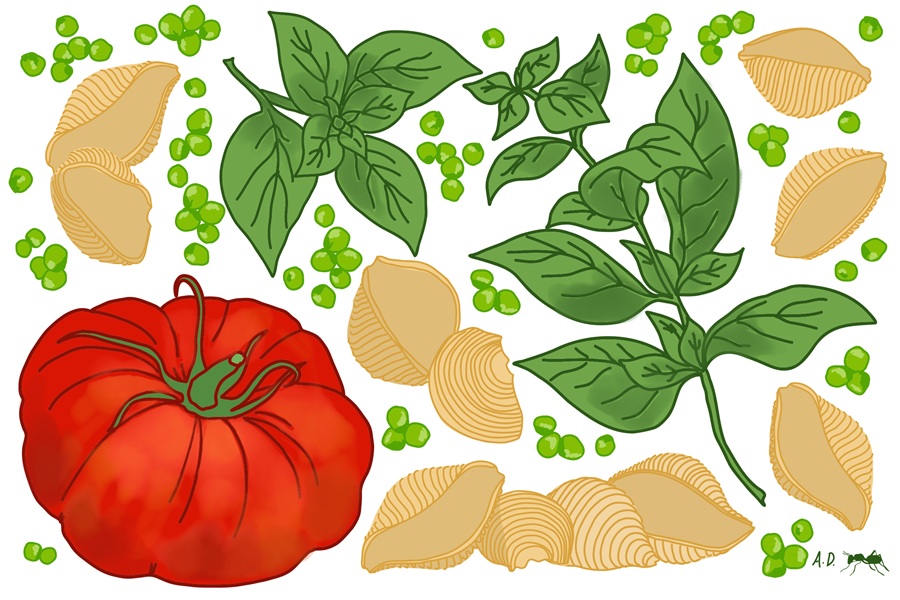When I was growing up, my birthday would often fall on the first day of school. This meant a day that combined excitement and dread involving kids I didn’t know yet staring at me as they sang an off-key “Happy Birthday.” The desire to slide down my plastic chair was always very strong.
Now, the date seems rather ideal. Early September is that time of year when the whole Cape gives off a big, almost audible sigh. The locals get their summer, complete with beautiful weather and easier left turns. The farmers markets are still filled with vegetables and flowers that are made sweeter and more vibrant by the cooler nights.

I try to soak this all in as I celebrate one more trip around the sun — something I believe should be joyously marked for a person of any age.
One of the best ways to celebrate, in my opinion, is with an excellent meal. In those back-to-school birthday years, my parents would cook all my favorites for dinner. I was an odd child in many ways but particularly when it came to food. For one, I liked broccoli better than PB and J. I got very excited about pimento-stuffed olives. I wouldn’t touch Lucky Charms, and American cheese made me feel queasy. At eight, I already knew the orange color of Cheez-Its was highly suspect. For years, this was my requested birthday menu:
Chicken broth with carrots and celery
Sweet potato (this hasn’t changed one bit)
Sautéed mushrooms
Gnocchi and peas
This last item was the most important in my mind. Gnocchi and peas is a quick, easy, and completely made-up family recipe that I still don’t know how to replicate. My father always did what I thought of as “kitchen magic” to make it. Vaguely, I know it involved butter, ricotta, milk, Parmesan, and frozen peas. Knowing my father and his love of making things quick when it comes to being in the kitchen, the mixture was surely heated in the microwave before being tossed with gnocchi. The result was creamy, delicious comfort food.
Like many foods that I enjoyed as a kid, I can’t eat this one anymore. It’s too much dairy, and many store-bought versions of gnocchi have gluten in them. Gluten-free gnocchi is a work in progress in my personal test kitchen, and when I’ve cracked it, you all will be the first to know.
For now, I have found something else that is just as comforting: a creamy, herby, vegan pasta sauce served with gluten-free pasta and perhaps some fresh tomato if the season is right. In honor of my childhood self, I usually throw in some peas, but this is completely optional.
Before I get to the recipe, let us have a moment of respect for the cashew. I understand that cheese is so good, and that you may think that nothing can replace it. Cashews, however, make a valiant effort with admirable results. Add raw cashews to a blender with some water, and you have a nice creamy “milk” for your cereal or coffee. Use less water and add some seasonings, and you have an excellent, nubbly “ricotta.” Let the blender run for longer and you will get a perfectly creamy sauce with no milk, cream, or cheese involved.
The key to creaminess is letting the cashews soak for an hour or two. If you have a high-powered Vitamix you can cheat and skip this, but soaking softens the nuts and really helps the texture of your finished dish.
The cashew pasta sauce I make can easily be modified to suit the season. The important thing is that you have an herb and an acid. My favorite version uses basil and a combination of lemon juice and apple cider vinegar. You could try oregano, thyme, tarragon, chives, or a combination instead. For the acid, try all lemon juice in place of vinegar or even lime juice. Sometimes I blend a half cup of frozen and thawed peas right into the sauce. This adds a slight sweetness. If you want things extra “cheesy,” add a tablespoon of nutritional yeast. You may want to decrease the salt if you go this route.
Luckily, pasta is one of those things that is very successful when made with ingredients other than wheat. There are pastas made with beans, rice, amaranth, or quinoa. You can buy gluten-free pasta that is black or red or that boasts a huge amount of fiber or protein. My go-to is an Italian brand called Bionaturae that makes an array of organic lentil and brown-rice pastas. A warning, though: the soggy pasta conundrum is worse with gluten-free pasta than the glutenous alternative. Test your pasta early and often. And please, salt your pasta water.
You might be wondering at this point: if this was a birthday meal, what about dessert? Trust me, I asked for cake with great exuberance. I wasn’t that weird a kid. My preference was always, and still is, carrot cake with cream cheese frosting. Two layers and toasted coconut on top, please. I always went back for seconds.
PASTA WITH CREAMY HERB SAUCE
Makes enough for 4 servings
For the sauce:
1 cup cashews
½ cup water
½ tsp. salt
2 small cloves garlic, pressed
1 Tbsp. apple cider vinegar
1 Tbsp. lemon juice
½ cup fresh basil leaves, a few leaves reserved
½ cup frozen peas, thawed (optional)
To serve:
1 lb. pasta, gluten-free if desired, any shape
About a cup of fresh or frozen green peas, steamed
A large, ripe heirloom tomato, sliced
- Soak the cashews for 2-3 hours. Rinse, drain, and add to the bowl of a food processor. Add the remaining sauce ingredients, including the peas if using, and pulse or purée until smooth.
- Chop the reserved basil leaves and stir into the puréed sauce. (Note that the sauce will keep in an airtight container in the fridge for up to three days.)
- Stir the sauce into warm pasta and serve topped with peas and/or sliced garden tomatoes.
Dry Summer Herbs Now for a Winter Bounty

Don’t let the season for fresh herbs go by without harvesting some extra to dry for the winter. Your future self will thank you when the flavors of summer are available for your January cooking. There are many options for saving herbs depending on how you want to use them, but here are a couple that I use in my kitchen.
Rosemary, basil, oregano, lemon verbena, sage, nettle, and thyme are all easy herbs to dry, and they keep their flavor well. For dried herbs, harvest before the plants start to flower. Strip the lower leaves, bundle 5 to 10 stalks with string, and hang upside down in a cool, dark place. The inside of a closet door is good for this if you are doing only a small quantity. The herbs should be fully dried in two to three weeks. Strip the dried leaves and store them whole or ground in an airtight container out of direct sunlight. They will keep for several months.
Another option is freezing. This is particularly good if you plan to use your herbs in soup. Harvest as you would for drying, then remove the leaves and rinse well. Chop to desired size and place one to two tablespoons in each cube of an ice cube tray. Fill the remaining space in each with water and place in the freezer. I like to use covered trays for this so that freezer smells don’t affect the herbs over time. —Antonia DaSilva



